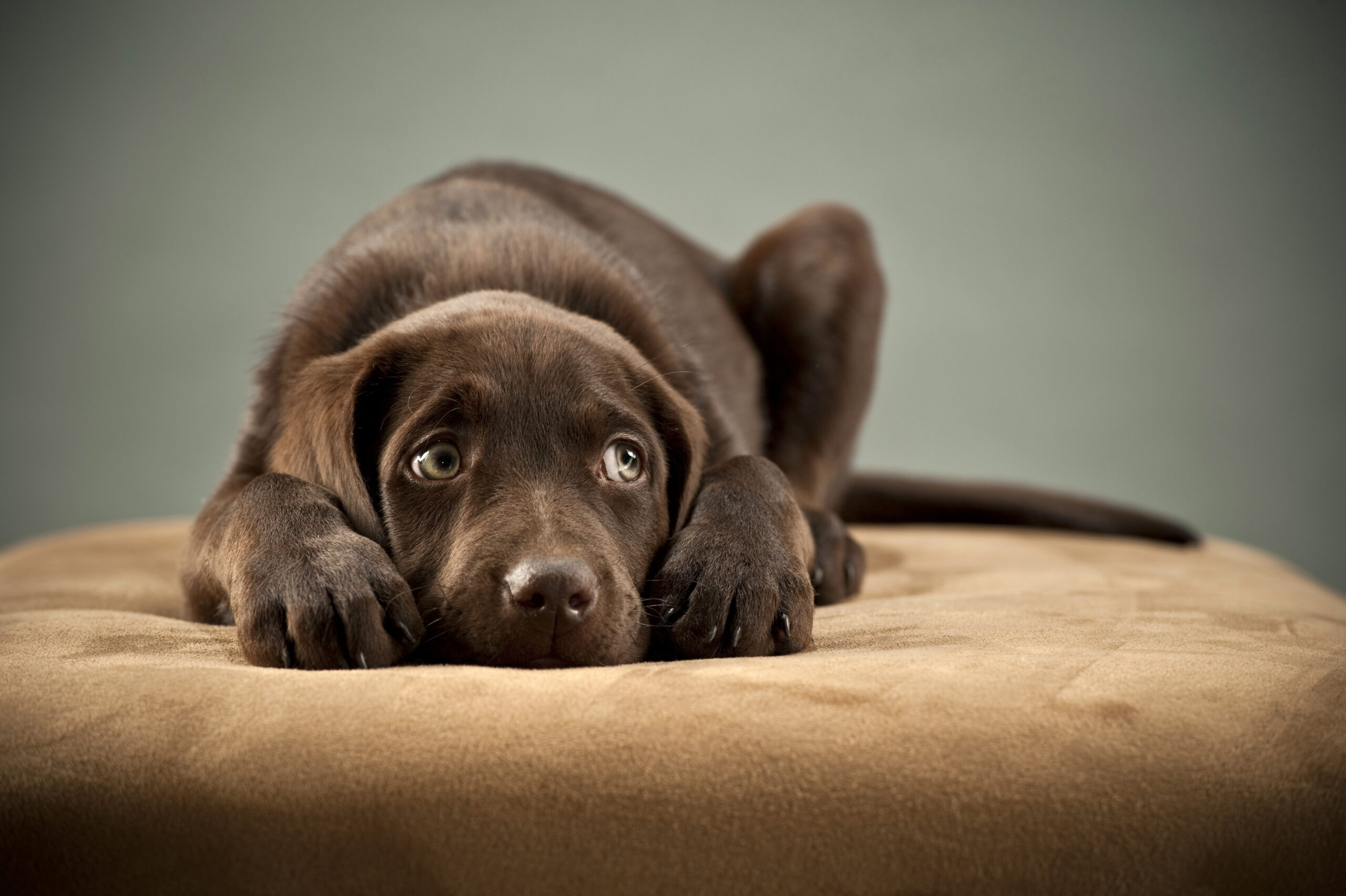Dogs can be frightening creatures, especially if something loud or unexpected happened. Some dogs will become anxious if they hear a loud automobile on the street, a rapid bike in the park, or a low-flying airplane. If it happens too frequently, your pet may even start to experience dog anxiety.
It may appear as though it just appeared overnight. When dog owner is searching for a good snuggle, they could find their dog huddled up in a corner, looking stunned at every floor creak.
However, what brings on canine anxiety, and what are the signs?

Why is my dog so scared of everything?
Dogs are not always as self-assured as they may appear. They are rather anxious creatures who occasionally overreact to everything around them. Many dogs don’t understand the concept of “chill,” from excessive excitement when their owner returns home—which can also be a symptom of separation anxiety—to the propensity to freak out at even the smallest inconveniences.
Having said that, there are typically some very clear explanations for anxiousness in particular. Dogs typically have a specific fear or worry, so it’s critical to identify what exactly is causing them to get anxious in the first place.
Understanding dog anxiety, stress, and fear
Every dog has its character, a unique personality influenced by different things.
These are the key factors that influence a dog’s personality:
• Hereditary factors
• Early childhood socialization
• Learned behavior
• Personal experiences
• Treatment by humans

Puppies and human newborns are similar in many ways. Like with children, a dog’s early years are crucial to its development into adulthood. A dog won’t be accustomed to the commotion of city life if it is raised in a calm, rural environment. In a similar vein, if your pet is accustomed to a bustling city, the calm countryside may be unsettling to them.
Dog mothers will pass on their concerns and fears to their puppies in the same way that our parents have an impact on our personalities. No dog has a great tolerance for significant changes, novel sounds, or unexpected situations, although some dogs are undoubtedly more uneasy than others. If kids are ever to overcome these phobias, they need to be patiently taught and raised.
Your responsibility as a dog owner is to give security, or at least the appearance of it. It’s never a smart idea to ignore a dog’s anxiety.
Anxious dogs are continually insecure, always feel threatened, and have a hard time calming down. This needs to be handled because it may result in violent or unpredictable conduct.
Dogs hate moving even more than you do
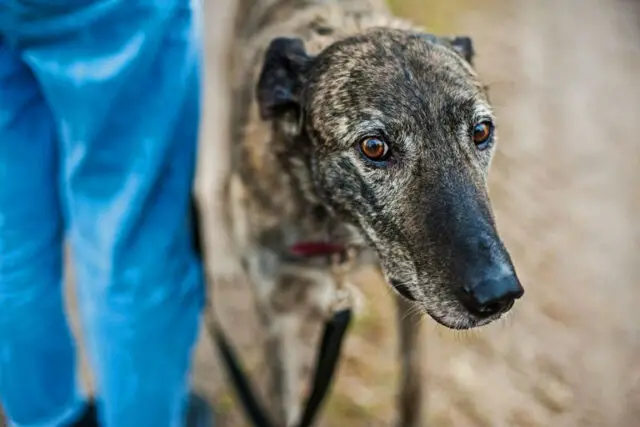
One of the most stressful things a person may go through is moving houses. However horribly stressful you may feel it to be, it is nothing in comparison to the effects it has on a dog that is unable to comprehend what in the world is happening.
You see, irrational fear is not necessarily the root of dog anxiety.
Instead, much as with us, stressful times can cause anxiety in dogs. Moving homes, especially when done overseas, may be very stressful.
This means that you should exercise caution when adopting canines that have traveled from another country. They can have gone through trauma, or they might just not have been properly socialized for the setting they are entering. You must therefore pay attention to their needs.
Ultimately, following a trying move or adoption, you need to boost your dog’s confidence. Take it gently, seek out competent instruction, and show lots of affection.
Recognizing dog anxiety symptoms
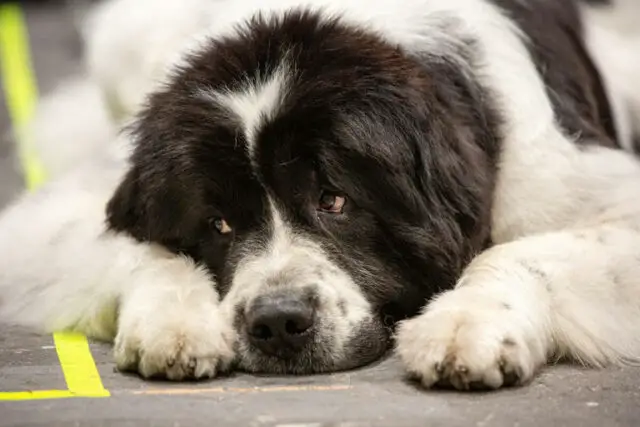
Anxious dogs have a wide range of distinct signs, all of which are readily apparent.
You can spot your dog’s nervousness and terror through these signs of acute dog anxiety.
Signs of an anxious dog in its behavior

All humans and dogs experience fear as a fundamental emotion at some point in their lives. Although each canine or person will respond to this emotion differently, everyone’s response will fall into one of these four categories.
1) Flight
Dogs will attempt to withdraw themselves from the source of their anxiety when they become frightened. Others will figuratively tuck tails and run, while some dogs will step aside or hide under their owners. If escaping isn’t an option, your dog might bite the leash and behave in an extremely hostile manner.
2) Fight
Some dogs will respond aggressively to acute stress, whether because of their personalities or their surroundings. They may snarl, snap, bite, and flog vigorously. If your dog’s eyes start to moisten, its pupil widens, and it tilts its ears back, that’s a sign that it’s about to attack.
3) Freeze
Although many individuals can identify with the feeling of freezing, dogs interpret the word in a somewhat different way. Dogs may remain motionless in the hopes that no one will see them, just as cats, reptiles, and some species of birds. You’ll observe that until whatever triggered their anxiety attack has passed, they won’t respond to commands or even to food.
4) Thoughtful play
Dogs who are afraid will ask their closest friends to play with them. If your dog is playing with another dog, you could notice that your pet occasionally stops to check the area to make sure no danger is there before continuing. They might also do a lot of jumping and running.
Body language dog anxiety symptoms
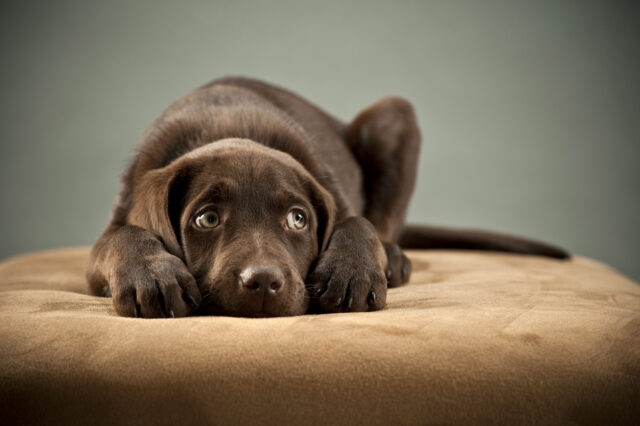
Anxious dogs frequently exhibit extremely particular body language signs. Simply monitoring how extreme these signs appear can help you determine how extreme the dog’s anxiety response is.
Body language symptoms of anxious dogs:
• Stiff posture
• Tail retracted or tucked between the hind legs
• Tucked and folded ears
• Neck sunken and retracted
• Folded limbs where possible
• Excessive panting and heavy breathing
• Severe trembling
• Head shaking
Always take canine anxiety seriously. It can soon deteriorate into a real disorder if not treated or addressed.
Symptoms of dog anxiety
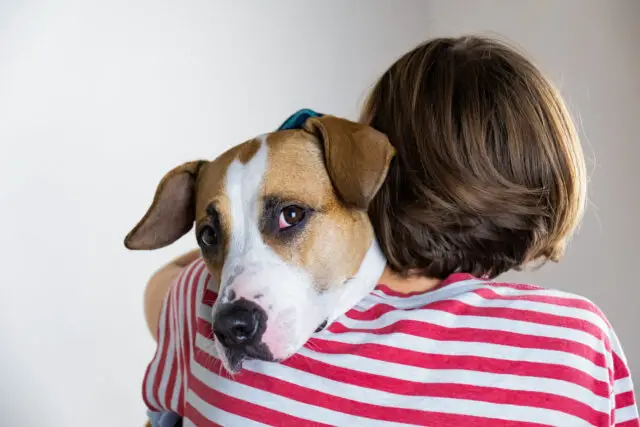
Dog anxiety can manifest in a variety of ways, many of which we’ve already covered. However, keep in mind that they frequently resemble the signs of anxiousness in people.
Symptoms of dog anxiety include:
• Loss of appetite
• Apathy
• Sudden emptying of bowels and bladder
• Sweating (wet paw prints)
• Excessive licking of the paws
• Self-injurious behavior
• Hair loss
• Exaggerated jumping reaction
You should take your dog to the vet if you see that they have been present for longer than four weeks in your dog. An anxiety problem may be present.
How to help a dog with anxiety
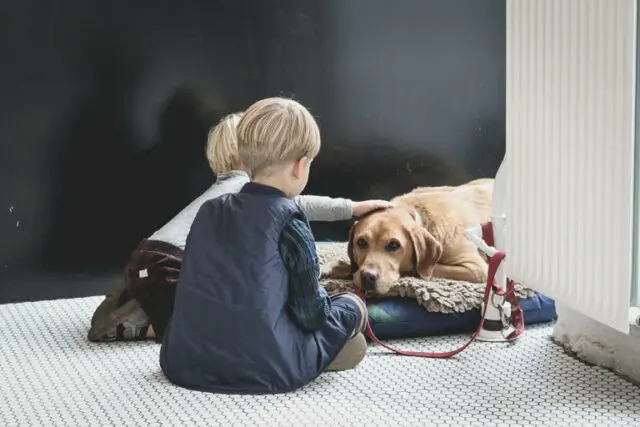
You should never disregard a dog exhibiting signs of fear or worry. Because doing so will just make everything worse.
There is no assurance that a dog’s worry won’t spread to other things if it is allowed to fester over an unaddressed fear.
You should base your response to a dog’s worry on both the cause and the character of the response. Before attempting to assist, a dog’s owner should also consider the dog’s personality and training.
Your strong dog may never be completely free of fear, and that’s alright. However, with practice and support, you should be able to at least enable them to function normally in daily life.
Fixing dog anxiety: finding out why
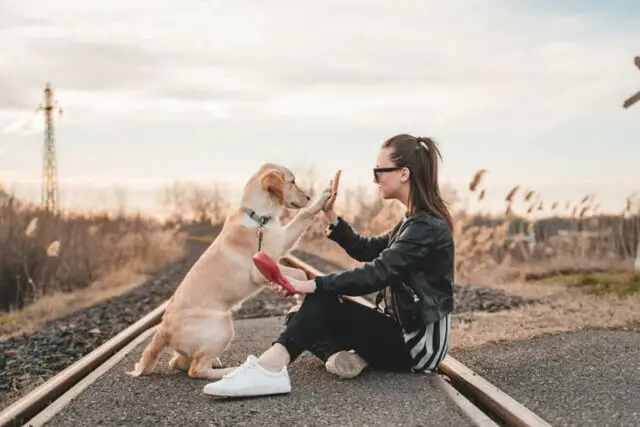
You must observe your dog closely to figure out exactly what is causing it to be anxious.
Here are some questions to ask yourself if you are trying to figure out why your dog is so anxious:
• Are there specific objects, people, or situations that frighten your dog? Have any appeared recently?
• Have there been any changes in your dog’s life, such as new people, a different walking route, or even a change in your perfume?
• Has your dog always been fearful? Are there any links that this might have to possibly negative or traumatic experiences it may have had?
• How exactly does the dog react to its anxiety? Does it want to flee, does it want to shelter in place, does it attack or overreact?
• Is your dog always in this state of anxiety, or does the fear come in waves?
• How have you been behaving recently? Are you excited about something? Is there a difficult situation at home? Are you tense or stressed out? Could you be inadvertently putting these feelings onto your dog?
• How have you reacted to your dog’s fearful or anxious behavior in the past?
• Where was the dog born and raised? Have you moved recently? Are there any environmental factors that could be causing this?
Understanding your dog’s anxiety is essential to figuring out how to address the issue and how to support your canine friend. This can help in figuring out how the dog should be trained going forward.
Remember: If your dog’s nervousness persists for an extended time, you should take them to the vet for a checkup. Pain, hormonal imbalances, or other conditions that can only be handled by a veterinarian could potentially be to blame for the anxiousness.
Help dog anxiety | What not to do
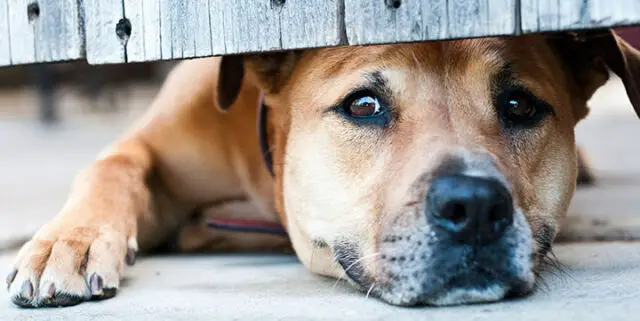
It’s not just people who can get triggered. Dogs also find some behaviors triggering.
Here is a selection of behaviors that are generally unhelpful when dealing with an anxious and fearful dog:
• Exuding fear and insecurity yourself
• Comforting the dog excessively, petting it, and giving it too much attention
• Pressuring, overtaxing, scolding, hitting, or punishing the dog
• Confronting the dog directly with fear whilst it is on a short leash
• Tugging on the dog’s leash and dragging or carrying the dog to the source of fear
• Cutting off the dog’s escape route, harassing, or cornering the animal
• Scaring the dog on purpose can permanently damage trust
Even though not all of these habits will negatively impact every dog, it is generally a good idea to steer clear of them if you wish to reduce your dog’s anxiety.
You should seek assistance from a veterinarian or a dog training facility if you are truly unclear about how to interact or behave around your frightened dog.
Fixing dog anxiety: training

As training offers dogs a sense of control and an awareness of their surroundings, it is essential for helping them deal with anxiety. Patience training can truly make a dog’s dread of a particular thing, person, or circumstance into something positive. A dog may become acclimated to the fear trigger after desensitization, eliminating that particular worry.
Let me give you an illustration of dog training. Let’s say your hair dryer is the source of the dog’s fear. Here is how you could move forward.
Step 1: Stop using your hair dryer in the presence of your dog. It may still be anxious at the sight of the thing, though, so you need to start with the physical distance between your dog and the hair dryer being quite large. Over time, bring it a little closer and, if your dog is calm, reward it.
Step 2: Now hold the hair dryer in your hand while you play with the dog or feed it. Allow the dog to sniff the device if it wants to. If it stays calm and shows no signs of fear, makes sure to reward your brave pooch.
Step 3: Once you have got your dog used to having it around, turn on your hair dryer while you’re in the dog’s presence. Start with the lowest setting, in another room, and then gradually get closer to the dog. Then do the same for the medium and high settings. If your dog remains calm, reward it.
Noise can be easily integrated into a dog’s daily routine, making the dog used to the noise and not fearful of certain devices, people, or places.
Keep these points in mind when training your dog:
• Your dog’s responses should always set the pace.
• Always positively reinforce your dog’s desired behavior.
• Do not punish your brave boy if something doesn’t work.
• Be patient and take your time.
• Do not force the dog to do anything if it is freaking out.
It takes a very long time to train your dog, and there may be numerous setbacks along the road. But it is worthwhile and will benefit not only you and your family but also your dog’s quality of life.
How to calm an anxious dog

Let’s go on to the main point of this article now. How can an anxious dog be calmed? To begin with, you must acknowledge that you are the alpha dog in your puppy’s eyes. You act as the dog’s confidant, the one who sets the rules, and you give your dog security and direction. Never breach this confidence, and always behave in a consistent and trustworthy manner.
Setting up limits and guidelines for your dog regularly is tremendously useful. Make sure that there is a clear framework that outlines what is and isn’t acceptable, how they should act, and that you sincerely love and care for your dog. Do not push your dog around or overburden it.
It’s just not how things work for your canine partner; it can’t do whatever the hell it wants. It must comprehend this, but it also needs to trust you in daily interactions and be taught how to respond appropriately if faced with a challenging circumstance.
Make sure you don’t react to your dog’s frightening situations too violently. This is crucial because your dog will be able to tell if something negative is happening by observing changes in your body language and emotions.
Know what your dog is afraid of and approach those situations calmly. Be sure to treat them lightly and carry on with your normal activities.
A dog’s self-confidence will be significantly boosted by effective training and engaging in fun activities with it. The dog will release the bonding hormone oxytocin through collaborative activity, and this will work against the stress hormone.
Hot Tip: To help your dog feel more secure and at ease, make sure that its canine companions share that feeling, and try to keep your buddy away from anxious or insecure canines.
What can you give a dog for anxiety?
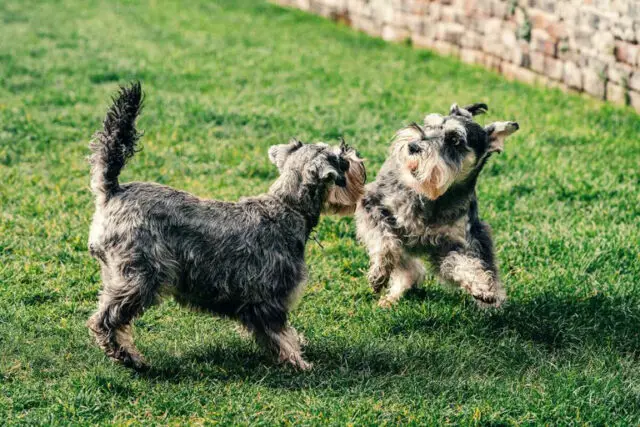
You should visit your veterinarian if you believe that you must provide your dog with medication in addition to kindness, compassion, and training.
Veterinarians frequently recommend the sedative Acepromazine, the pheromone Adaptil, as well as different Amino Acids and other dietary supplements to anxious dogs.
Each of them affects your dog differently and offers varying degrees of assistance.
However, before using any pills or treatments to treat dog anxiety, you must visit a veterinarian and receive a prescription.

